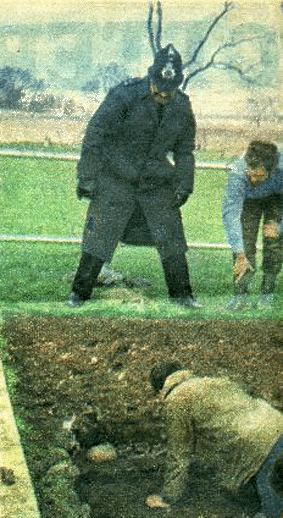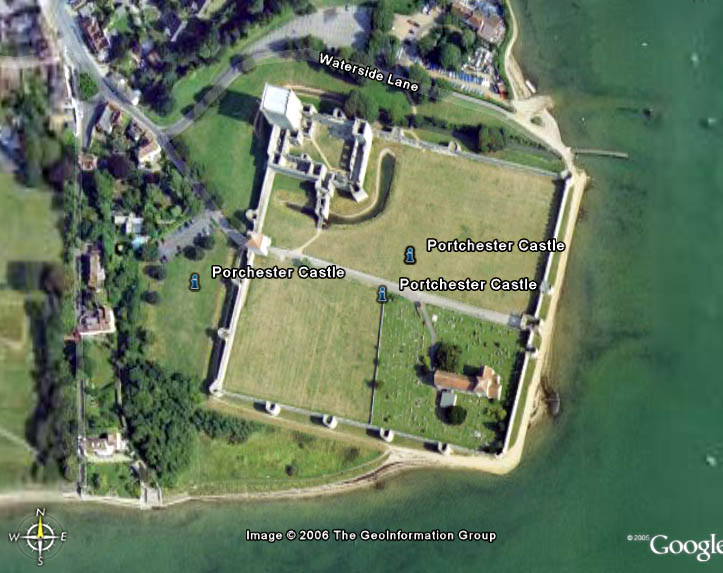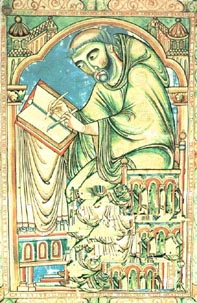Portchester Castle  Still digging!
Still digging!
Portchester (Portus Adurni) has been the site of habitation before
the Romans. Today it is best known for its Norman keep but the outer walls
are essentially intact and Roman, being one of the constructions of the
"Saxon Shore" fortifications. Within the walled area, excavations in 1965
revealed a gravelled parade ground from the 1600's, wattle and daub from
the Saxon period and beam slots from wooden buildings of the Roman period
dated to the late 300's from coins of Carausius and Allectus.
A number of subsequent medieval inhumations were also found.

|

|
| Volunteers at Portchester
carefully examine the evidence after all the hard work has been put
behind them. |
The long arm of the law
reaches back 2000 years. |
It may be from Portchester that emperor Vespasian in the 1st
century A.D. embarked for the seige of Jerusalem after subduing S.E. Britain
& the Isle of Wight. A clump of trees near Portchester is said to be
where St. Paul landed, now known as Paulsgrove.
Pre-Roman Settlement
 Higden a Christian monk at Chester recorded in A.D. 491 that
there was a British camp at Portchester (called Caer-Peris). Higden
also stated that there were two brothers here, Ferrex and Perrex sons of
Sisil who fought each other, Perrex (Peris) being the victor. As a
result Perrex was crowned king. He founded and fortified the town where
Portchester Castle now stands calling it Caer Peris after himself. However
the murder of Ferrex was avenged by his mother Idon, "who with her maidens
when he was asleepe, cut him all in pieces and after this the land was divided
into three kingdoms" . Higden a Christian monk at Chester recorded in A.D. 491 that
there was a British camp at Portchester (called Caer-Peris). Higden
also stated that there were two brothers here, Ferrex and Perrex sons of
Sisil who fought each other, Perrex (Peris) being the victor. As a
result Perrex was crowned king. He founded and fortified the town where
Portchester Castle now stands calling it Caer Peris after himself. However
the murder of Ferrex was avenged by his mother Idon, "who with her maidens
when he was asleepe, cut him all in pieces and after this the land was divided
into three kingdoms" .
"After the death of Cymbeline (Cunobelinus*) the government fell to
Guiderius (Caractacus), his son. This prince refused to pay tribute to
the Romans, for which reason Claudius, the emperor of Rome marched against
him (A.D. 43-48). Hamo, the commander of the Roman forces made an attack
on Caer Peris and began to block up the gate with a wall" (probably a seige
to starve the British). But in a battle Hamo killed Guiderius upon which
his brother Arviragus took command and under him they pushed the Romans back
to their galleys. Later in the absence of defenders, Claudius assaulted Caer
Peris and took it".
[*circa A.D. 5-10 to 40-43 Shakespeare's Cymbeline ("Old King Cole") is
the only king whose memory has survived in British tradition through Geoffrey
of Monmouth. A Roman writer refers to him as "Rex Britanniarum" which signified
defiance of Rome, however he never provoked war. He controlled the Trinovantes
a tribe centred on CAMVLODVNUM (Colchester) and all south-eastern Britain
except the Iceni in East Anglia]
Late Roman period
In the Comes Litoris Saxonica (Count of the Saxon Shore) in
282 Saxon long boats were reported in the Channel.
By 286 Carausius, a Belgic seaman, was sent by Rome to supress pirates
having obtained the command of the Saxon Shore, but he himself became
a pirate by capturing the plunder and enriching himself. Carausius escaped
to Britain with his entire fleet, welcomed by the Britons and the only
remaining Roman legion, and declared himself emperor of Britain.
Carausius minted his own coins, probably at nearby Bitterne (CLAVSENTVM).
About 1942 two skeletons were found at Portchester with coins in the
skull which were probably placed under the tongue to pay Charox to ferry
them across the River Styx.
Carausius made Portchester his naval station and dockyard and
established his power after he defeated a Roman fleet, such that his independence
had to be accepted by the Roman emperors Diocletian and Maximanus as Augustus
of Britain. During the reign of Carausius, Pevensey (Anderida) and Portchester
(Portus Adurni) were strengthened.

|
The outline of the 1965 excavations
can be seen as a N-S linear structure in the SW quarter of the castle grounds
However he had a brief reign, when a "friend" & subordinate,
Allectus murdered him in 293. Three years later the Caesar, Constantius
Chlorus crossed the Channel, Allectus being forewarned, assembled a fleet
at Spithead and on the first news of the Romans being at sea under
Asclepiodotus he pushed round the Isle of Wight into the main channel to
intercept them. Owing to dense fog he failed in his purpose and Asclepidotus
having effected a landing burned his ships. Thereupon Allectus also landed
his fighting men, fought the Romans and was defeated and fell, Britain was
then restored to The Roman Empire. From now on the Romans kept a garrison
at Portchester.
When a house was being built about 1900 by a Mr. Harry A. Evans
in a field he had purchased at Portsea Island, workmen found broken
pottery and a burial urn in the upper end of what was previously called
Lump's Lane (now Lump's Fort rose garden). Pottery was also found in
the nearby cemetary. In the urn were almost 1000 Roman coins which may represent
a hoard hidden by an officer who had been ordered back to Rome and never
returned, but this could just as easily be pillaged money.The coins were
from the reigns of Trajan (98 -117 A.D.), Antoninus pius(138-161) and
Marcus Aurelius Antoninus(121-180) but most of about 350 A.D.
In 410 an appeal from Britain ("The groan of the Britons") was made to
Honorius (395-423) the emperor in the West. Honorius who had ruthlessly
persecuted the Christians, replied "let the communities look after themselves"
After Vortimer, (Vortigern's son) had died, Ambrosius Aurelianus, one
of the last Romans, became king after the British king Vortigern1
Arthur, the legendary British hero is believed to have fought and lost
a battle near Portchester under Ambrosius against the Saxons or Jutes.
From the Anglo-Saxon Chronicle 501 A.D:
| "In this year, Porth and his two sons Bleda & Maegla came to
Britain at the place called Portsmouth (Portesmutha) and there they killed
a young British man of very high rank" |
 This battle may have taken place on Portsdown Hill nearby or at
Portchester. The Anglo-saxon Chronicle states that the battle took place
at Longborth ("The haven of the ships"). The young man of high
rank may have been (St.)Geraint from Cornwall killed in the battle
which was led by Arthur at Portsmouth (according to a Welsh poem)3.
This battle may have taken place on Portsdown Hill nearby or at
Portchester. The Anglo-saxon Chronicle states that the battle took place
at Longborth ("The haven of the ships"). The young man of high
rank may have been (St.)Geraint from Cornwall killed in the battle
which was led by Arthur at Portsmouth (according to a Welsh poem)3.
The Saxons arrived in two large "galleys" under the command of Porth
and his two sons.
Twelve Saxons were killed. At least five burial sites occur on
the Portsdown Hill one being predominantly a cremation cemetary, two being
primary barrow burials the other two predominantly inhumation cemetaries2.
At one cemetary, three tumuli occur just east of Fort Purbrook, each
measured at 6 metres diameter (1965) with large flints on the surface indicating
the bedrock had been excavated from beneath the soil which here is about
110cm thick.
In 1816 "workmen opened two barrows a few yards east of where
Fort Purbrook (a Napoleonic fort, one of "Palmerston's Follies") now stands
on Portsdown. They contained twelve skeletons of men most probably slain
in battle. Some were in cists, others were just laid on the chalk and covered
with surrounding soil. Embedded about three inches into the top of the skull
of one of the bodies was the top of an iron spear or pike, and beside another
a spear head".
However some later reports suggest these remains are Iron Age. In 1966
an Iron Age encampment with a deep surrounding ditch was excavated at
Hoylake just to the West. An Iron Age burial was found at the George public
house and a burial mound between Hoylake and the George which now lies
under a house.
One report suggests Bleda may have settled his family at Bedenham
and Maegla at Elson.
The Saxon chieftain Cedric who had landed on the River Itchen in 495
A.D. was supported by Kentish and Sussex tribes as well as Porth and his
two sons to campaign against the Britons under Nazanleod. Nazanleod
fell with ?5000 of his army.
From 495 to 645 A.D. there was peace but in 645 Cenwalh, king of the
West Saxons having put away his wife, a princess of Mercia caused her brother
Penda to declare war and drove Cenwalh from his kingdom.
A battle which gave Penda possession of Portchester appears to have
been fought on Portsdown Hill, just uphill from Paulsgrove. Remains of
what are believed to be Penda's camp are still to be seen at the place
called Rocker's Corner near the road leading to the village of Southwick.
All along the bottom of the Portsdown Hill between Cosham and Portchester
are traces of ancient encampments.
PREVIOUS
 Edwin the Scribe says: I dig archaeology
HOME Edwin the Scribe says: I dig archaeology
HOME
References/Sources:
1. Acts of the Kings of England, William of Malmesbury
2. Britain in the Dark Ages, Ordnance Survey, second ed.
3. The Realms of Arthur, Helen Hill, 1970.
4. The Observer colour supplement, 1965.
5. Google Earth.
© Copyright Tim Midgley 2002 revised 12th
August 2023.
|
 Still digging!
Still digging! 



 This battle may have taken place on Portsdown Hill nearby or at
Portchester. The Anglo-saxon Chronicle states that the battle took place
at Longborth ("The haven of the ships"). The young man of high
rank may have been (St.)Geraint from Cornwall killed in the battle
which was led by Arthur at Portsmouth (according to a Welsh poem)3.
This battle may have taken place on Portsdown Hill nearby or at
Portchester. The Anglo-saxon Chronicle states that the battle took place
at Longborth ("The haven of the ships"). The young man of high
rank may have been (St.)Geraint from Cornwall killed in the battle
which was led by Arthur at Portsmouth (according to a Welsh poem)3.

